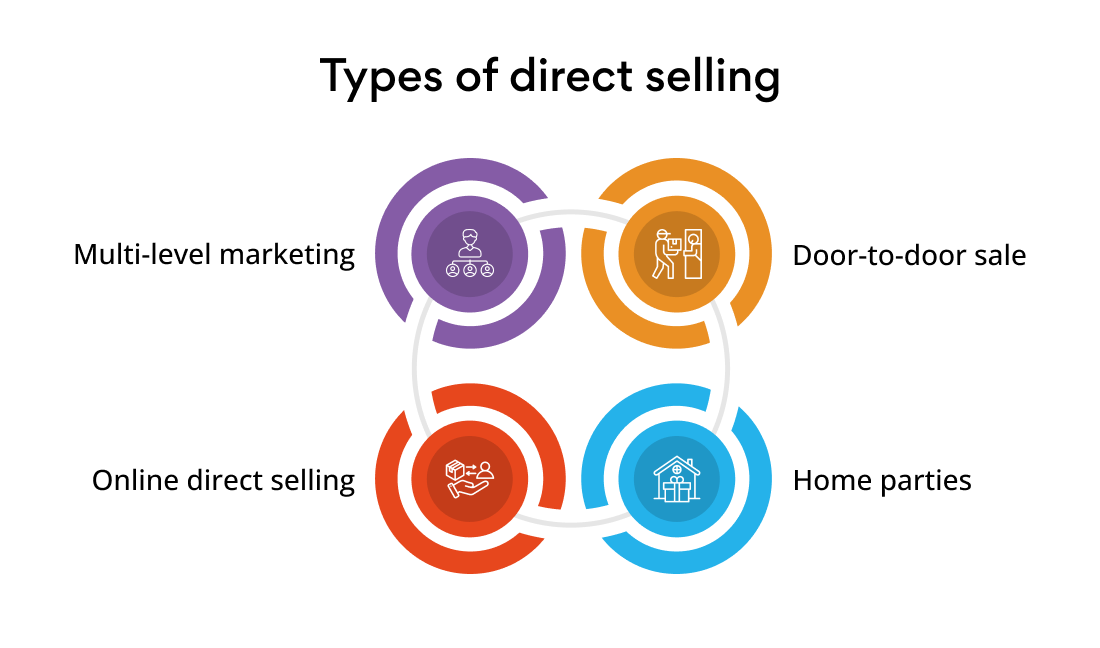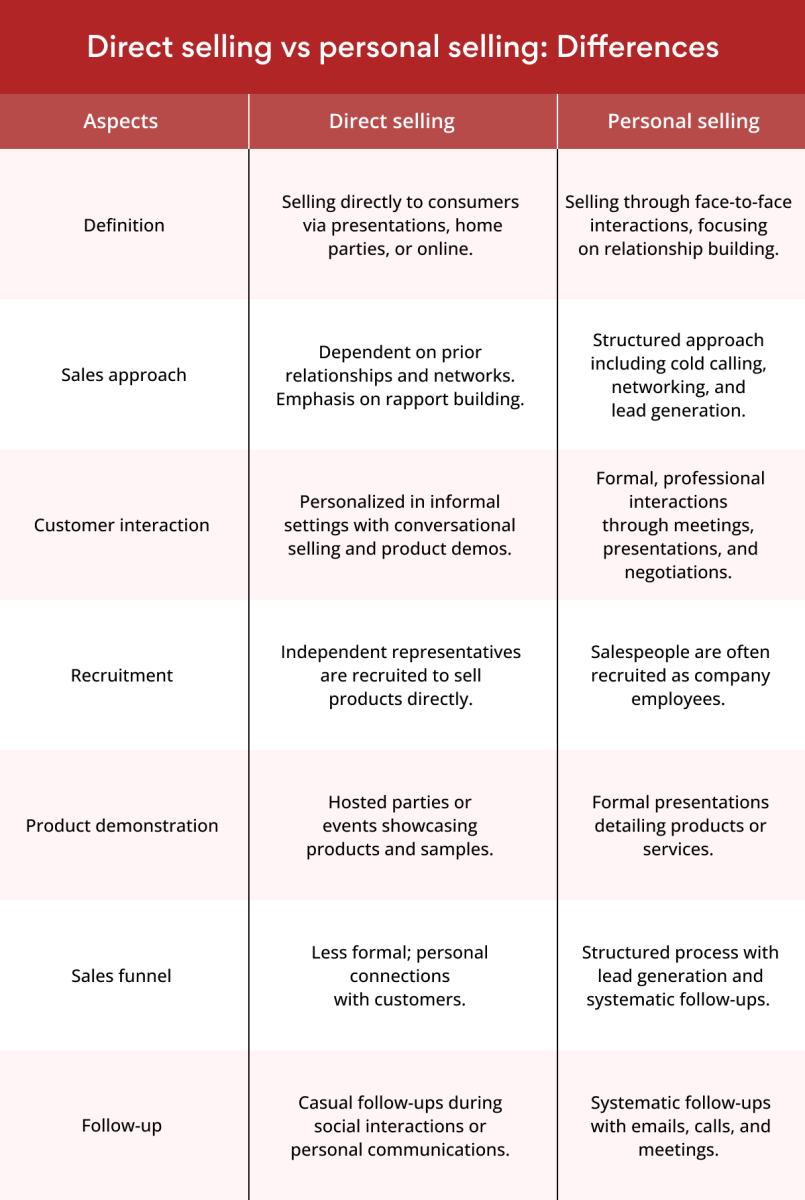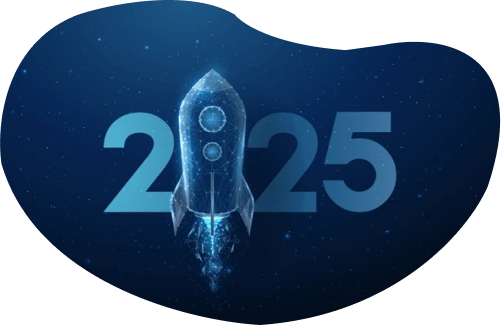Businesses often find themselves doing direct selling vs personal selling when it is about driving sales and fostering customer relationships. Understanding various shades of these two selling strategies is crucial for any company making projections of enhanced market presence and happy bottom lines.
Direct selling involves pitching products directly to consumers, without the aid of traditional retail channels. This method relies on independent sales representatives whose sales and marketing strategy is hinged on building personal connections with customers. From the prospect’s side, this approach is highly personalized and devoid of any psychological pressure.
In direct selling vs personal selling, the latter is an umbrella term for any face-to-face selling scenario. This approach is highly interactive and involves direct communication between a salesperson and potential buyers. Personal selling focuses on building strong relationships, understanding customer needs, and providing tailored solutions. It is a crucial component of B2B transactions and high-value consumer sales where trust and personal interaction impact purchasing decisions.
Choosing the right sales approach can sink or float a business. Strategizing sales approach involves careful study of the target market, product type, and overall business goals. A decision settling direct selling vs personal selling influences sales performance and impacts brand reputation. This blog will provide a comprehensive comparison between the two sales approaches to help businesses make informed choices for their sales operations.
What is personal selling?
Personal selling is a sales technique wherein the sales representative uses interpersonal skills in a one-on-one interaction with the prospective customer. This method is directed towards building relationships by not being a ‘pushy’ salesman. The customer’s needs are understood and product features are presented as customized solutions to meet those needs. Personal selling is characterized by its personalized and consulting approach. It has built-in space for immediate feedback and adjustments to sales strategies. Personal selling can occur in various environments, like retail stores, trade shows, business meetings, or over the phone. The various methods of personal selling could be:
Face-to-face sales
This is a tried-and-tested method that works on direct and meaningful interaction between the salesperson and the customer. It takes place in a real-time scenario, where the salesperson can address concerns, and close sales on the spot.
Consultative selling
This method has the salesperson acting as an advisor. They focus on understanding the customer's specific needs before talking about a product or solution. Product knowledge is transformed into a tailored solution that is positioned according to the customer’s needs. Here, relationship building is prioritized over talking about the product’s features. A consultative approach leads to increased satisfaction and stronger buyer-seller relationships.
Relationship selling
Relationship selling is a technique that first builds a connection with customers and potential buyers to close sales. The salesperson focuses on interaction with the customer. They nurture the relationship through regular follow-ups, and prompt service not using the price and other details to sell a product or service. This form of personal selling brings in repeat sales.
Examples of personal selling
There are many industries that employ personal selling as a business strategy to reach their target customers, as well as market their products for better sales.
Real estate agents
Real estate agents use face-to-face sales and relationship selling methods. They build rapport with their potential buyers by showing properties and discussing features and benefits vis-a-vis the latter’s needs. Successful agents maintain relationships with their clients, which might lead to repeat business and referrals.
Luxury goods sales
This is another product where sales representatives use consultative selling to assist customers in choosing the right products. For instance, a salesperson in a luxury watch store will recommend the most suitable watch based on the customer's preferences, lifestyle, and budget.
Technology solutions providers
Companies selling complex technology solutions use consultative selling. A software sales representative will engage with a business to understand its challenges and demonstrate how their software can address specific issues. They might even offer a tailored solution to fulfill the client's needs.
Following will be an explanatory juxtaposition of personal selling vs direct selling to give you a clearer picture of what might suit you best in your entrepreneurial venture.
What is direct selling?
In direct selling vs personal selling, one can easily get confused when discerning differences at a glance. Both are methods of sales, but they differ in their approach, target audience, and context.
Direct selling is a retail channel used to market products and services directly to consumers. It can happen in a prospect’s home, online platforms, workplaces, or other non-store locations. The essence of direct selling lies in the personal interaction between the seller and the buyer, facilitated by independent sales representatives or distributors.
Types of direct selling
Direct selling encompasses a range of methods for different audiences and selling styles. The most common methods include:

1. Door-to-door sales
This is a traditional method that involves sales representatives visiting every selected home in the market area assigned to them. Every home is a prospective client to whom they demonstrate products or services. This method continues to be a cornerstone of direct selling due to the personal touch and immediate interaction it offers.
2. Home parties
This method involves hosting a gathering at someone’s home where a sales representative demonstrates products. Guests can try, ask questions, and purchase items in a relaxed, social setting. This method encashes social networks and peer recommendations.
3. Multi-level marketing (MLM)
This method creates a network of distributors. They sell products and earn commissions on their sales and the sales made by their recruits on multiple levels. This sales technique builds widespread reach and exponential sales growth.
4. Online direct selling
Online direct selling: The internet has helped many direct selling companies transition to online platforms. Their representatives employ social media, personal websites, and virtual parties to reach a broader audience without geographical constraints.
Examples of direct selling
Real-world examples help illustrate how direct selling operates across different methods:
1. Mary Kay Ash:
Mary Kay Ash grew her cosmetic company into a billion-dollar enterprise with direct selling. Today, Mary Kay is one of the largest direct selling companies in the world, boasting over 3 million independent beauty consultants.
2. Herbalife:
Herbalife was founded in 1980 by Mark Hughes to promote healthier lifestyles through nutritional supplements and weight management products. The company adopted a direct selling model to introduce a unique meal replacement shake into the market.
3. Pampered Chef:
Pampered Chef offers kitchen tools and cooking products through direct selling. Representatives host cooking demonstrations at home gatherings or online, showcasing products in action and providing cooking tips to potential buyers.
Direct selling vs personal selling

Direct selling and personal selling, are customer-centric sales techniques that focus on direct customer interaction. However, the similarity ends in their approaches, customer engagement, and sales processes. An understanding of these distinctions and a knowledge of their products, target market, and sales goals can help businesses opt for an appropriate strategy.
Direct selling: Direct selling brings products to the consumer's doorstep. It is through one-on-one presentations, home parties, or online platforms that the representative introduces the product to the customer. Companies like Herbalife, Coway, and Betterware are prominent examples of businesses that use direct selling models.
Personal selling: Face-to-face interaction is the key to this sales method. The principle is to build relationships with clients before pushing the product in front of the prospect. This approach is most common for B2B sales, real estate, and automotive industries.
Sales approach comparison
One key difference in the discussion of direct selling vs personal selling is the choice of sales approach.
Direct selling: In this method, sales are mainly dependent on prior relationships and personal networks. Representatives are usually independent contractors who identify potential customers within their social circles. The emphasis is on building rapport through follow-ups, demonstrations, and personal recommendations.
Personal selling: It employs a structured approach that includes cold calling, networking, and lead generation to find potential clients. The focus is on understanding the customer's needs and providing bespoke solutions.
Customer interaction in selling
Both strategies require a distinct style of customer interaction for a successful sales pitch.
Direct selling: Interaction is highly personalized in informal settings like homes or social gatherings. It uses a conversational selling process that provides in-depth product demonstrations and encourages customers to try products before purchasing.
Personal selling: Here, customer interaction can be formal and professional. Salespeople engage with customers through scheduled meetings, presentations, and negotiations. The interaction is goal-oriented and focuses on closing sales through nurtured long-term relationships.
Sales process differences
Another significant difference between direct selling vs personal selling is the process of recruitment, lead generation, prospecting, and negotiation:
Direct selling:
- Recruitment: Companies recruit independent representatives who sell products directly to consumers.
- Product demonstration: Representatives host parties or events to showcase products and offer samples.
- Sales funnel: The process is less formal wherein the representative connects with customers personally.
- Follow-up: Follow-ups are casual and happen during social interactions or through personal communications like phone calls or messages.
Personal selling:
- Lead generation: Salespeople generate leads through networking, referrals, and marketing campaigns.
- Sales presentation: A formal presentation is made to the client, which talks about the product or service in detail.
- Negotiation: This happens before the closure. The salesperson negotiates terms and prices.
- Follow-up: Follow-ups are systematic and involve multiple touchpoints. These include emails, calls, and meetings aimed at fostering long-term relationships.
Critical differences in approach, customer interaction, and sales processes
Approach:
Direct selling relies on personal networks and informal settings.
Personal selling involves a structured process and formal presentations.
Customer interaction:
Direct selling interactions are conversational and take place in casual environments.
Personal selling interactions are professional and goal-oriented.
Sales processes:
Direct selling has a flexible and personal sales process determined by the representative's relationships.
Personal selling follows a formalized process with systematic lead generation, presentations, negotiations, and follow-ups.
Key factors to help you make the right choice for your business
The selection of a sales approach depends on the importance and urgency of your business goals. Direct selling and personal selling cater to different strategic objectives:
Business goals
Direct selling:
- Expansion and reach: Direct selling has independent salespeople or distributors leveraging their networks. This broadens market reach exponentially without the need for high capital investment.
- Low-cost market entry: Direct selling provides a low-risk entry point with minimal upfront costs. It reduces the need for a large sales force and infrastructure.
Personal selling:
- Relationship building: Personal selling is ideal for businesses that work on personalized interactions, fostering trust and maintaining loyalty.
- High-value products: Businesses dealing with high-value products need detailed demos and customized solutions to market their product. Personal selling is best for such businesses.
| Business goals | ||
|---|---|---|
| Aspect | Direct selling | Personal selling |
| Expansion and reach | Leverages networks of independent salespeople to broaden market reach. | Focuses more on deepening existing customer relationships rather than broad market expansion. |
| Low-cost market entry | Low-risk entry with minimal upfront costs and reduced need for large infrastructure. | Requires consistent recruitment and training. Can be investment intensive. |
| Relationship building | Builds relationships through distributors and networks, but with less personal interaction. | Ideal for personalized interactions, fostering trust, and loyalty. |
| High-value products | Less suited for high-value products requiring detailed explanations. | Best for high-value products needing detailed demos and customized solutions. |
Target audience
Understanding your target audience is crucial in determining the most effective selling method:
Direct Selling:
- Consumer products: Direct selling works best with consumer products that require a personal touch or demonstration. Examples include cosmetics, wellness products, and kitchenware.
- Community-oriented markets: If your target audience values community opinions and personal endorsements, direct selling can be a perfect fit.
Personal selling:
- Business-to-business (B2B): Personal selling works very well where decision-making involves multiple stakeholders, similar to a B2B environment. It allows sales representatives to give a public demo and negotiate terms.
- Technical or specialized products: Personal selling is preferred for products requiring detailed explanations.
| Target audience | ||
|---|---|---|
| Aspect | Direct selling | Personal selling |
| Consumer products | Best for products requiring a personal touch (e.g., cosmetics, wellness products). | More effective for niche or specialized consumer products requiring detailed information. |
| Community-oriented markets | Fits well if the audience values community opinions and endorsements. | Less dependent on community influence, more on individual decision-makers and stakeholders. |
| Business-to-business (B2B) | Less common in B2B, better suited for consumer markets. | Effective for environments with multiple decision-makers, like B2B settings. |
| Technical/Specialized products | Less effective for products requiring detailed technical explanations. | Preferred for products requiring detailed explanations. |
Resources and capabilities
Evaluating your company’s investing capabilities will help you zero in on a sales methodology.
Direct selling:
- Minimal sales infrastructure: Direct selling requires less internal sales infrastructure. This is most appropriate for startups and companies with limited sales capabilities.
- Software infrastructure: Choosing customizable direct selling software can cut down your efforts and resources in half.
Personal selling:
- Dedicated sales team: Personal selling necessitates a dedicated and skilled sales team. Consistent investment in training programs is essential to ensure sales representatives remain conversant with the product. Investment in CRM and other software tools to manage and maintain customer relations. Therefore, it can be costly.
| Resources and capabilities | ||
|---|---|---|
| Aspect | Direct selling | Personal selling |
| Minimal sales infrastructure | Requires less internal infrastructure, suitable for startups, and limited sales capabilities. | Demands a robust sales infrastructure, including a skilled team and CRM tools, leading to higher costs. |
| Dedicated sales team | Relies on independent distributors, reducing the need for a large, dedicated sales team. | Needs a skilled sales team and consistent investment in training and CRM tools. |
Market conditions
Analyzing market conditions will help you determine which sales approach is more favorable:
Direct selling:
- Emerging markets: Direct selling fits very well in markets with growing consumer bases but less developed retail infrastructure.
- High competition with similar products: Products earn an edge over competition through personal touch and customer testimonials.
Personal selling:
- Mature markets: Personalized service and building strong customer relationships are best suited for mature markets with established competition.
- Complex decision-making processes: Personal selling allows space for consultation and negotiation, where purchasing decisions involve multiple layers of approval.
| Market conditions | ||
|---|---|---|
| Aspect | Direct selling | Personal selling |
| Emerging markets | Fits well in markets with growing consumer bases and less developed retail infrastructure. | More suited to mature markets with established competition and structured decision-making processes. |
| High competition | Gains an edge through personal touch and customer testimonials. | Competes by providing tailored solutions and building strong, personalized customer relationships. |
| Mature markets | Less effective in mature markets where personalized service is expected. | Best for mature markets with established competition, focusing on personalized service and relationships. |
| Complex decision-making processes | Less suited for environments with complex decision-making. | Allows for consultation and negotiation in complex purchasing decisions. |
Discover how we build resilient businesses with advanced MLM functionalities
Conclusion
Settling the question of personal selling vs direct selling is not a one-size-fits-all decision. Neither can it be an absolute choice. You can lean towards the personalized touch of personal selling or the expansive reach of direct selling. But, the wisest path forward lies in a nuanced understanding of your business goals, target audience, and market conditions. By aligning your sales strategy with these factors, you can harness the plusses of either method to drive business. Ultimately, choosing between personal and direct selling is about maximizing your reach, building enduring customer relationships, and adapting to the ever-evolving market dynamics.









Leave your comment
Fill up and remark your valuable comment.